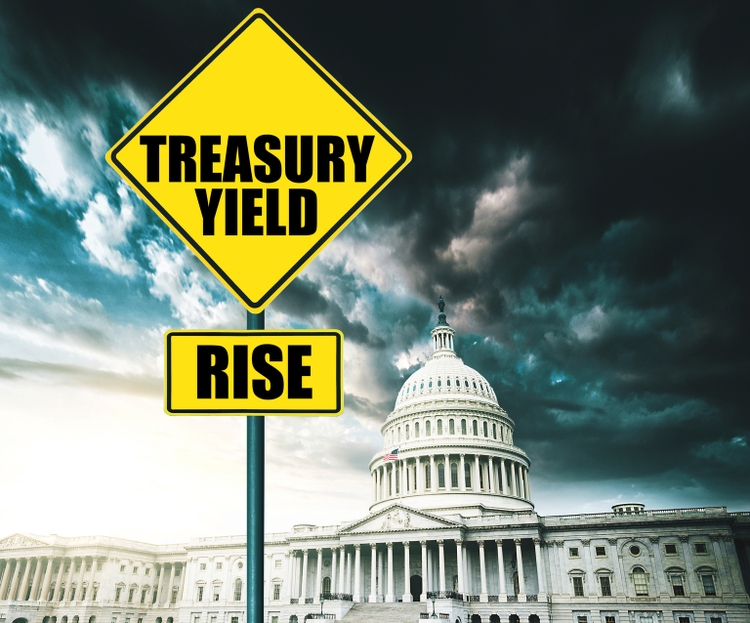Business
Treasury Yields Climb on October 10, 2025: Key Rates Revealed

The yield on the benchmark 10-year Treasury note reached 4.05% on October 10, 2025, reflecting ongoing shifts in investor sentiment and Federal Reserve policies. The yield on the two-year note settled at 3.53%, while the 30-year note recorded a yield of 4.63%. These figures illustrate the current landscape of U.S. government bonds, which have been influenced significantly by monetary policy decisions.
In recent months, the Federal Reserve’s stance on interest rates has been a critical factor in shaping market expectations. As the central bank navigates inflationary pressures and economic growth, bond yields have fluctuated in response. The rise in the 10-year yield suggests that investors are anticipating a tighter monetary policy, which could signal higher borrowing costs in the near future.
Market analysts note that the 10-year note’s yield is often viewed as a barometer for broader economic conditions. A yield above 4% typically indicates investor concerns over inflation or an expectation of rising interest rates. In this context, the current yield reflects a cautious outlook among investors regarding the economic recovery and the effectiveness of the Federal Reserve’s interventions.
The two-year note, yielding 3.53%, also plays a significant role in this dynamic. It is generally considered a more immediate indicator of interest rate expectations, often moving in tandem with the Fed’s policy decisions. The relatively lower yield compared to the 10-year note implies that investors may be factoring in a slower pace of rate hikes in the short term.
Meanwhile, the 30-year note’s yield at 4.63% highlights longer-term investor sentiment. This yield is crucial as it affects mortgage rates and long-term borrowing costs for consumers and businesses alike. A higher yield here can lead to increased costs for homebuyers and could dampen the housing market.
The Treasury yield curve provides insight into market predictions, with an inverted curve often signaling recession fears. Currently, the yields suggest a normal curve, indicating that investors are optimistic about medium to long-term growth, despite short-term uncertainties.
As the Federal Reserve prepares for its upcoming policy meetings, the bond market will continue to react to economic data and indicators. Investors will be closely monitoring inflation reports and employment figures, which could further influence Treasury yields in the coming weeks.
In summary, as of October 10, 2025, the U.S. Treasury yields reflect a complex interplay of economic factors and Federal Reserve policies, with the 10-year note standing as a key indicator of market sentiment. The movement in these yields will likely remain a focal point for investors as they navigate the evolving economic landscape.
-

 Lifestyle1 month ago
Lifestyle1 month agoWinnipeg Celebrates Culinary Creativity During Le Burger Week 2025
-

 Health2 months ago
Health2 months agoMontreal’s Groupe Marcelle Leads Canadian Cosmetic Industry Growth
-

 Science2 months ago
Science2 months agoMicrosoft Confirms U.S. Law Overrules Canadian Data Sovereignty
-

 Education2 months ago
Education2 months agoRed River College Launches New Programs to Address Industry Needs
-

 Technology2 months ago
Technology2 months agoDragon Ball: Sparking! Zero Launching on Switch and Switch 2 This November
-

 Science2 months ago
Science2 months agoTech Innovator Amandipp Singh Transforms Hiring for Disabled
-

 Technology2 months ago
Technology2 months agoGoogle Pixel 10 Pro Fold Specs Unveiled Ahead of Launch
-

 Science2 months ago
Science2 months agoChina’s Wukong Spacesuit Sets New Standard for AI in Space
-

 Technology2 months ago
Technology2 months agoWorld of Warcraft Players Buzz Over 19-Quest Bee Challenge
-

 Technology4 days ago
Technology4 days agoDiscord Faces Serious Security Breach Affecting Millions
-

 Business2 months ago
Business2 months agoDawson City Residents Rally Around Buy Canadian Movement
-

 Technology5 days ago
Technology5 days agoHuawei MatePad 12X Redefines Tablet Experience for Professionals
-

 Business2 months ago
Business2 months agoNew Estimates Reveal ChatGPT-5 Energy Use Could Soar
-

 Science2 months ago
Science2 months agoXi Labs Innovates with New AI Operating System Set for 2025 Launch
-

 Technology2 months ago
Technology2 months agoInnovative 140W GaN Travel Adapter Combines Power and Convenience
-

 Education2 months ago
Education2 months agoAlberta Teachers’ Strike: Potential Impacts on Students and Families
-

 Technology2 months ago
Technology2 months agoFuture Entertainment Launches DDoD with Gameplay Trailer Showcase
-

 Technology2 months ago
Technology2 months agoGlobal Launch of Ragnarok M: Classic Set for September 3, 2025
-

 Technology2 months ago
Technology2 months agoNew IDR01 Smart Ring Offers Advanced Sports Tracking for $169
-

 Technology2 months ago
Technology2 months agoArsanesia Unveils Smith’s Chronicles with Steam Page and Trailer
-

 Technology2 months ago
Technology2 months agoHumanoid Robots Compete in Hilarious Debut Games in Beijing
-

 Science2 months ago
Science2 months agoNew Precision Approach to Treating Depression Tailors Care to Patients
-

 Business2 months ago
Business2 months agoBNA Brewing to Open New Bowling Alley in Downtown Penticton
-

 Health2 months ago
Health2 months agoGiant Boba and Unique Treats Take Center Stage at Ottawa’s Newest Bubble Tea Shop










